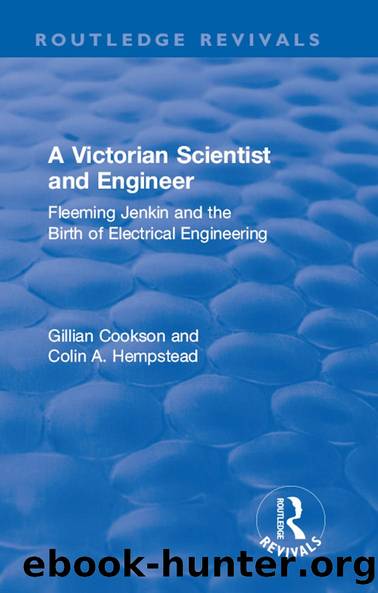A Victorian Scientist and Engineer by Gillian Cookson Colin Hempstead

Author:Gillian Cookson, Colin Hempstead [Gillian Cookson, Colin Hempstead]
Language: eng
Format: epub
Tags: History, General
ISBN: 9781351788366
Google: 4Lo6DwAAQBAJ
Publisher: Routledge
Published: 2017-10-19T05:01:33+00:00
Figure 5.2 : Fleeming Jenkin in Edinburgh, c.1880 (Jenkin mss)
I would rather see my own class form part of an institution which is partly literary; and I would rather see in the peopleâs college a literary side not separate from science. I would rather carry it on as a university.101
This is consistent with an opinion expressed to the Devonshire Commission, where Jenkin had suggested that his chair was âthe better for being in the university. I think my students are better for the students that they meet. I think that I myself am better for the professors that I meet with and associate withâ.102
Jenkinâs model of engineering education was not one which flatly opposed practical training in universities. He admired the fellow pupil at Fairbaimâs who had received a scientific education as well as some workshop instruction at Kingâs College.103 His objection was to the system practised on the continent, where there was no pupilage and all engineering training took place in colleges.104 This opinion was based upon pragmatics, as Jenkin judged that the British system, with all its shortcomings, still produced better engineers than even the best German polytechnics. He was convinced that industrial conditions could not at that time be usefully replicated in the laboratory. He was not on principle attempting to divide the teaching of theory from practical work. Indeed Jenkin concurred with Thomson and his Glasgow circle in emphasising a harmony of theory and practice in the making of a professional engineer.105 He did not see theory and practice as opposing each other, or as in competition for superiority, or for that matter as overlapping â they were separate things. âBut what is the use of theory if you cannot put it into practice?â106
How much of this educational model was Jenkin actually able to translate into practice? In Edinburgh, he started with the advantage of launching a new degree course with a good deal of autonomy. He had Baxterâs backing and believed that Scottish students would come to him better prepared than had been the case in London. He had already rejected some applicants, and had set up âa proper matriculation examination, such as would be required for medical men â¦â107 His two year course, for undergraduates aged from sixteen to eighteen, aimed to be highly theoretical and would emulate continental preparatory courses.
If we could get students to enter upon their pupilage as well prepared as [continental students] are when they enter on those special courses, I think we should then get a class of very much better engineers; a class possessing, in fact, all the theoretical knowledge we need.108
Jenkin went on to specify what he intended to include in this foundation course:
You want to teach them mathematics as far as they are required to enable men to apply them to ordinary engineering problems ⦠You cannot take the whole range of engineering, but you can show them, for instance, how geometry is applied in mechanical drawing. In my own course I can show them how physics and chemistry, and mathematics, are all applied in certain definite examples.
Download
This site does not store any files on its server. We only index and link to content provided by other sites. Please contact the content providers to delete copyright contents if any and email us, we'll remove relevant links or contents immediately.
Patriot by Alexei Navalny(337)
Museum of Antiquity by T. L. (Thomas Louis) Haines(276)
The Story of Joan of Arc by Andrew Lang(260)
The Memoirs of Pere Labat, 1693-1705 by Jean Baptiste(233)
The Apollo Moon Missions by Randy Walsh(233)
Richard III and the Princes in the Tower by A.J. Pollard(230)
2,2-Dimethyl-3,4-dihydro-2H-1,4-benzoxazines as isosteres of 2,2-dimethylchromans acting as inhibitors of insulin release and vascular smooth muscle relaxants by Bernard Pirotte & Xavier Florence & Eric Goffin & Philippe Lebrun(229)
Fry The Brain: The Art of Urban Sniping and its Role in Modern Guerrilla Warfare by John West(188)
A History of the Peninsular War, Vol. 5, Oct. 1811-Aug. 31, 1812 by Charles Oman(179)
The Memoirs of Count Grammont â Complete by Hamilton Anthony Count Walter Scott(177)
1916 - The Battle of the Five Empires: 15 May - 28 September 1916 by Benoît Chenu(174)
Life of Napoleon Bonaparte, Volume I. by Walter Scott(174)
Maleficium: Witchcraft and Witch Hunting in the West by Gordon Napier(171)
Rasputin the Rascal Monk by William Le Queux(162)
Famous Fights of Indian Native Regiments by Reginald Hodder(159)
BY MARK Twain, Twain - The innocents at home by 1881(148)
Father Browne's Titanic Album by E. E. O'Donnell(146)
The Thoughts of Marcus Aurelius by Marcus Aurelius(143)
Joanna of Flanders by Julie Sarpy(133)
